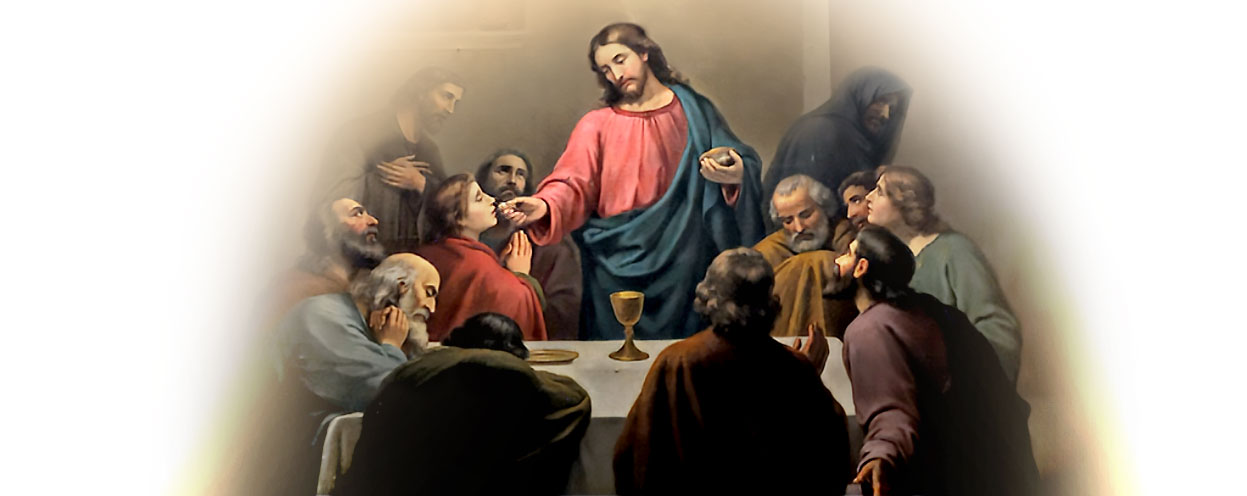Whoever believes will be saved

The Resurrection of Jesus Christ is an objective historical fact that happened in a specific place and time. Any attempts to question it are an ideological speculation, having no foundation in reality.
The Resurrection of Jesus concerns each of us personally, as it gives an ultimate sense to our life, suffering and death. Rising from the dead, Christ freed us from the terrible captivity of Satan, sin and death. To each of us, totally undeservedly, Jesus gives the joy of eternal life in heaven. We will share in the joy of Resurrection only if we cast away all sin and grow to hate it, if we adhere to the Person of the risen Lord with the faith and trust of a child, and if we subordinate all our life to Him.
Why did they believe?
Jesus died as a condemned person on a cross. This was the most ignominious kind of death. He was crucified close to the busiest gate of Jerusalem, on the day of preparation for Passover, when the number of pilgrims coming to the city was the largest. Jews considered any condemned man suspended from a wooden cross as one cursed by God.
Why did pious Jews believe in the Resurrection of Jesus who was an itinerant teacher and preacher and who had been condemned to the most ignominious kind of death by crucifixion? What is more, those pious Jews believed that risen Jesus was God. Why did they believe in the Resurrection and true divinity of Jesus if they considered any such claims to be the most horrible blasphemy (see Mark 2:6-7)? And it was those pious Jews that began to preach with unusual courage that Jesus had risen from the dead and that He was true God; they were prepared to suffer martyrdom to defend this truth. They believed in something, which earlier had been for them, believers in the only God Yahweh, the gravest offence and blasphemy. How could this happen?
The only explanation of this incredible metamorphosis is the shocking fact of Christ’s Resurrection. Jesus, who had died on a cross after a terrible agony and had been buried in a grave, rose on the third day and met His disciples, came to them despite a closed door, gave them final advice and had meals with them. The apostles and disciples knew for a certainty that Jesus had resurrected and that He was God. At that very time when it appeared that Jesus suffered an utter and ignominious defeat, He himself brought them a joyful certainty of faith that He had risen from the dead – it was on this foundation of faith that the Church was built. In a short time, across the Roman Empire, Christianity began to spread like wildfire despite continuous cruel persecutions, which did not make the apostles and Jesus’ disciples renege on the belief in His resurrection – they would rather suffer martyrdom.
Is it possible not to believe such witnesses who laid down their lives for the truth they preached? Such steadfast faith in Christ’s Resurrection was shared by His apostles and disciples. This faith is handed down from generation to generation in the community of the Church; it has reached our times and continues to subsist although in the meantime, powerful civilizations and kingdoms fell.
Absolute novelty
The truth about Jesus’ Resurrection was an absolute novelty not only for Judaism but also for all other religions. There are no texts outside of Christianity which would mention a god that became man and who as a man, died and rose from the dead.
To realize better how incredible is the fact that it was the pious Jews who were first to believe in the Resurrection of Christ, one has to remember the teaching of Judaism on the Messiah and His Resurrection. The most renowned biblical scholars, including David Flusser – the greatest Israeli authority on the history of the second Temple, stress that in Jesus’ times there was no theological trend in the whole of Judaism that would maintain that the Messiah would have to die and rise from the dead. No one in the Chosen People expected the Messiah to suffer, to be defeated and to rise from the dead. Much less to be crucified. Jews expected that at the end of time the bodies of all the dead would be resurrected and the final judgement would be held. It must also be remembered that the idea of purely spiritual resurrection, without the body, was self-contradictory and nonsense to Jews. For a Jew to convince himself of the fact of resurrection and then speak of it, he would have to see first a resurrected body, or even touch it, to make sure with his own senses that it actually existed. That is why, St. Thomas said to the other apostles: Unless I see the nail marks in his hands and put my finger where the nails were, and put my hand into his side, I will not believe (John 20:25).
Whereas for people steeped in Greek culture, the idea of the resurrection of bodies was absurd and nonsensical. For Greeks, the body had no importance whatsoever; only a soul was considered immortal and was freed from the prison of the body at the time of death. It was for this very reason that St. Paul was ridiculed and treated as a backward semi-literate in Athens when he told Greeks that Christ had died and risen from the dead as a true God and a true man (see Acts 17:18ff). The teaching of the Death and Resurrection of Christ was an absolute novelty and at the same time was an ‘outrage’ to the Jews and ‘nonsense’ to pagans.
The historicity of the Resurrection
Professor Jacques Perret, head of the Chair of Roman History at the Sorbonne, a historian of an international standing, applied scholarly criteria of studying historical texts to the descriptions of the Resurrection of Christ in the New Testament. The results of his study were published in the book Ressuscité: approche historique (FAC Editions, 1984). In the conclusions, the author writes that historical research unequivocally shows that the Evangelists relate the basic truth about Christ’s Resurrection. If a person rejects the belief in Christ’s Resurrection, there are no historical reasons for the rejection. Any scholar who earnestly searches for the truth and who, using the criteria of the latest historical research methodology, studies the biblical texts relating to Jesus’ Resurrection will come to the logical conclusion that they speak of an objective historical truth. Professor Perret stresses that denying the credibility of what we read on Jesus’ Resurrection in the New Testament is a result of either plain ignorance or ideological assumptions and prejudice, and not the result of research.
Professor Perret criticizes some modern liberal biblical scholars who claim that it is not possible to study the historicity of the Resurrection because it had no witnesses. The same scholars maintain too that the texts of the Holy Scriptures on the Resurrection are not credible because they were written by believers. The scholarly value of such reasoning is assessed by Prof. Perret in the following words: ‘If a historian of antiquity used in his research the methods applied by some biblical scholars who claim that the Gospels do not deserve credence, such a historian would become the butt of jokes of all his colleagues’.
The fact that the Resurrection itself had no witnesses does not justify the claim that its historicity is ruled out. The risen Christ appeared to specific people in a specific time and place. After all, by coming to know effects, one can trace their causes. The claim that the Gospels are not credible because they were written by believers is absurd in itself. Professor Perret argues that it would not be possible to write any history if we had to reject all the authors who were in one way or another involved in the events they gave an account of.
Moreover, Professor Perret writes that the encounters with the risen Christ are described in the New Testament as events experienced with senses by their witnesses and not as products of their faith. After all, the risen Christ is seen by Paul, an unbelieving persecutor of Christians, who is immediately converted after meeting the risen Lord. The apostles and disciples, who earlier did not even think that Jesus might rise from the dead, see Him, talk to Him and have a meal with Him. As a result, they are convinced that He truly resurrected. Similarly, Apostle Thomas stubbornly did not believe in the account of Jesus’ Resurrection given by the other apostles; only after Thomas met Christ in person did the wall of unbelief collapse in him. These events show that the appearances of the risen Lord did actually happen, ones that could be experienced with human senses.
The Resurrection has a fully transcendent dimension but it also has an experienceable and historical one that must not be ignored or denied. It is true that the belief in the Resurrection is far above the human mind but it is after all based on hard facts and does not contradict reason as does, for instance, the belief shared by those who claim that there is no God and life developed by itself. How very naive are all those who, against common sense, believe in theories on the rise of life, speaking of ‘autogenesis’, ‘chance and necessity’ or ‘blind evolution’ – that the blind power of evolution from abiotic matter automatically produced an intelligent man.
As early as the 2nd century AD, pagan Celsus, combating Christianity, claimed that the main source of information on the Resurrection of Jesus was a hysterical woman (Magdalene). The arguments against the Resurrection of Jesus used by Celsus are the same as the claims by some 19th-20th-century ‘scientists’. They claim that the appearances of the risen Christ were a result of hallucinations or some other subjective desires and deceptions by His disciples. According to unbelievers, the Resurrection of Jesus was a ‘subjective’ event which took place in the minds of people connected to Jesus. It is clear that the arguments of people opposing the belief in the Resurrection have not changed. These are not new theories, formulated after carrying out a thorough research, but unfounded rubbish conceived in the minds of people who hated Christians. It dates from the early years Christianity and is repeated in a pseudoscientific form today too.
The people who earnestly search for the truth, who are unprejudiced and free from any ideological assumptions, discover that the Resurrection of Jesus is an objective fact that took place in a specific time and place. Admittedly, it had no witnesses but there are witnesses of its effects; they saw an empty grave and an intact shroud (on which Jesus left an impression of His whole body), and met the risen Lord on many occasions, talked to Him and had meals with Him.
How credible are the accounts of the Resurrection?
According to the latest research by biblical scholars, including Jean Carmignac, John A.T. Robinson, Claude Tremontant and Paolo Sacchi, there are plenty of reasons to believe that the synoptic Gospels (according to Matthew, Luke and Mark) were written in the Aramaic or Hebrew language at a time when Christianity was still confined to Israel. Hence, the synoptic Gospels were edited between ten and twenty years after the shocking events of the Passion, Death and Resurrection of Christ. The account of the Gospels is highly believable; they give both historical facts and news of salvation. When Christianity began to spread across the Mediterranean, it was necessary to translate the Gospels into Greek. Thus we have the texts of the Gospels dating from ca. 50 A.D. It must be remembered in this context that Fr. Prof. José O’Callaghan discovered that a piece of papyrus from the Qumran cave (sealed prior to 68 A.D.) bore several fragments of words from the Gospel according to Mark. This is an archaeological corroboration of the fact that the news of Jesus’ Resurrection was publicly proclaimed with great enthusiasm, joy and courage in Jerusalem and across Israel immediately after His Death and Resurrection. At that time, all those who had Jesus condemned to death and crucified were still in power; they included Pontius Pilate, Roman procurator of Judea, the Sanhedrin, the High-Priest Joseph Caiaphas and his father-in-law Annas.
Jesus was sentenced to be crucified for blasphemy for being a man, He claimed to be God (see Matt. 26:65-66). A worse blasphemy still for the Sanhedrin was to proclaim that Jesus resurrected and that He was true God. It was for this very reason that Stephen, the first Christian martyr, was stoned to death followed later by the executions of Apostle James and the other apostles. Had not the Resurrection been an objective fact, the Sanhedrin and the Roman authorities could have easily ridiculed the first propagators of the truth of Jesus’ Resurrection by showing His dead body – if of course the body had existed. Since Jesus’ grave was empty, they could not do this.
The belief in the Resurrection and Divinity of Jesus Christ was born only because Jesus appeared to others and let Himself be recognized as being alive after His Resurrection.
No one saw with his or her own eyes Jesus rise from the dead – hence the books of the New Testament do not give a description of this event. The Gospels contain no fantasies but only accounts of the facts that took place. The authors of the New Testament describe the events related to the Resurrection of Jesus in a strictly impartial and truthful manner. The descriptions are complementary and do not contradict one another. The accounts given by the evangelists mention three visits of women at the grave of Jesus. The description of the first visit (in the Gospels by Matthew and Mark) mentions the appearance of one angel and recounts that Mary, the mother of James, and Salome resolved not to tell anybody of it (Mark 16:8). During the second visit described in the Gospel by John, Mary Magdalene sees two angels and informs Apostles Peter and John that the grave is empty (John 20:1). Finally, during the third visit at the grave by several women, described in the Gospel by Luke, they have a vision of two angels in the empty grave and they told all these things to the Eleven and to all the others (Luke 24:9).
Jesus invites the apostles and disciples to meet Him in Galilee but this does not stop Him from appearing to them first in Jerusalem. Three women went to the grave when it was still dark while others went there after sunrise. Peter and John saw intact shrouds in the grave from which the body of Christ was gone, which entirely convinced them of His Resurrection. Peter was astounded by what he saw, while John immediately believed that Jesus had risen from the dead. The Gospel accounts of the Resurrection are therefore based on historical facts.
The community of the Catholic Church came into existence when the news of Christ’s Resurrection began to be proclaimed: God has raised this Jesus to life, and we are all witnesses of it (Acts 2:32). The proclamation of this news is the most important mission of the Church. The historical fact of Jesus’ Resurrection is the clearest sign that He is our Saviour, true God who became a true man, and who died and rose from the dead for us and our salvation.
Don’t be an unbeliever
After Jesus’ disgraceful death on the cross, the apostles and disciples were completely disappointed, dejected, let down and convinced that everything was over.
Jesus resurrected in His true body that had stayed in the grave for three days. Appearing after the Resurrection in His glorified and deified body, not subject anymore to the laws of physics, He let Himself be recognized by the apostles and disciples using their senses of sight, hearing and touch. Over 40 days from the moment of His Resurrection, Jesus gave his disciples many convincing proofs that he was alive. […] and spoke about the kingdom of God (Acts 1:3).
When Jesus appeared to the apostles they were startled and frightened, thinking they saw a ghost. He said to them, “Why are you troubled, and why do doubts rise in your minds? Look at my hands and my feet. It is I myself! Touch me and see; a ghost does not have flesh and bones, as you see I have. When he had said this, he showed them his hands and feet. And while they still did not believe it because of joy and amazement, he asked them, “Do you have anything here to eat?” They gave him a piece of broiled fish, and he took it and ate it in their presence. (Luke 24:37-43). Similarly, Jesus overcomes Thomas’s disbelief: Put your finger here; see my hands. Reach out your hand and put it into my side. Stop doubting and believe (John 20:27).
Through physical contact, the apostles became convinced that Jesus rose in the same body in which He had been crucified and deposited in the grave. Over the course of forty days, they met the risen Christ in person on many occasions. In this way they became certain that He was truly alive in the glorified body that was not subject to physical limitations any longer. After the Resurrection, Jesus could appear and disappear or enter the house (‘Upper Room’) through a closed door where the apostles were.
The belief in the Resurrection was born and strengthened as a result of direct contact with Jesus who appeared humbly and without any triumphant notes. The apostles could recognize His voice, hair, face as well as His hands and side – together with the wounds left by the Crucifixion – and experience the joy of the ultimate victory over death, sin and Satan.
The risen Christ is continuously present in His Church, forgives all sins in the Sacrament of Penance; in the Eucharist, He gives us a remedy granting immortality – an antidote to death. He cures all wounds of the heart and frees from all addictions – but you have to believe Him, trust Him completely and establish a personal contact with Him.
When we unite with Christ in an everyday persistent prayer, when we accept from Him the gift of eternal life in the Sacraments of Penance and Eucharist, when we renounce all sin and fulfil His will, then we share in His victory over death, hell and Satan, and experience the joy of Resurrection already here, on earth.
Death has been swallowed up in victory “Where, O death, is your victory? Where, O death, is your sting?” But thanks be to God! He gives us the victory through our Lord Jesus Christ (1 Cor. 15:55, 57).
Do you like the content published on our website?
Support us!





